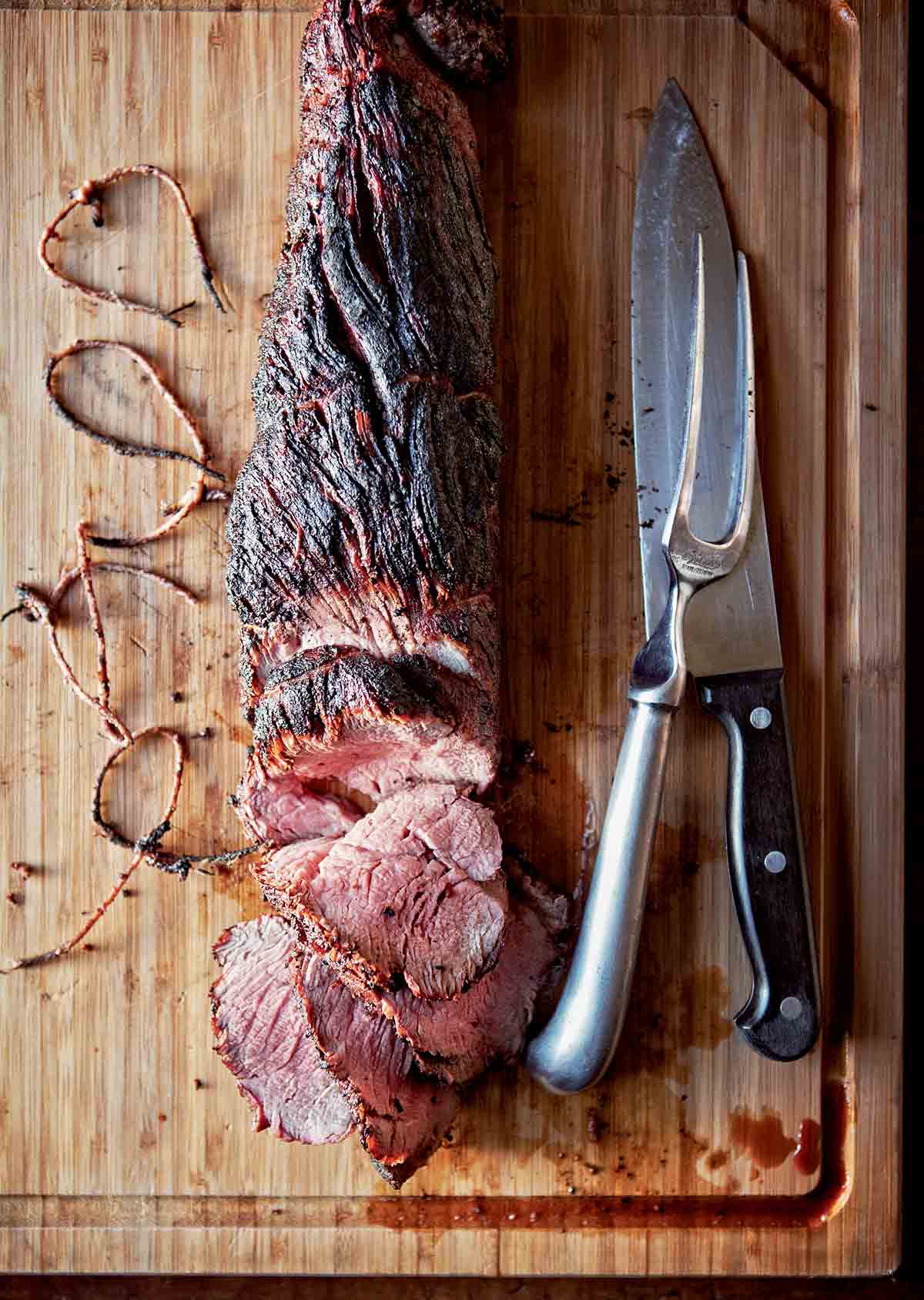
This grilled whole beef tenderloin with herbed compound butter speaks to lovers of simple things done exceptionally well. A simple rub, a memorable herb-flecked butter, and a failproof grilling technique are all it takes.
Although the beef may be a bit pricey, it’s worth every penny. It feeds a crowd, there’s very little waste, it’s easy to cook, and the tenderness and flavor rival anything you’d experience at a snooty restro.
As one of our testers who made this explained, “Skip the stuffy steakhouse, grab a nice bottle of red, and stay in your PJs.”–Angie Zoobkoff
Why Our Testers Loved This
Tester Jessie Hagan describes this grilled tenderloin as “the most tender, buttery steak” she’s ever had and calls it “utterly and perfectly indulgent.” Kinda makes you want to try it, doesn’t it?
Notes on ingredients
- Fresh herbs–use any combination of your favorite fresh herbs, or stick to just one. If you prefer, you could make a lemon, paprika, or horseradish variation by following this compound butter recipe.
- Beef tenderloin–Ideally, you want a piece of meat that has a uniform thickness so that it cooks evenly. If you have a tapered end to your tenderloin, fold the narrow part underneath to create a uniform shape and tie the roast at even intervals. You also want your tenderloin to be trimmed and any silver skin removed. You can do this yourself or ask your butcher.
Step-by-step instructions
- Make the compound butter. Beat the butter until smooth and creamy. Mix in the herbs, shallot, and garlic, and season well.
- Prepare the tenderloin. Pat your beef dry and trim away any fat along with the silver skin. Fold the thin flap of meat under the rest of the tenderloin and tie it at even intervals with kitchen string.
- Rub the beef all over with oil. Season well with salt and pepper and let stand at room temperature while you prepare the grill for medium-hot indirect grilling.
- Grill the beef over direct heat until it develops a crust. Move the tenderloin to indirect heat and continue to cook until it reaches your desired doneness. (120°F (49°C) for rare and 130°F (54°C) for medium-rare, 7 to 12 minutes.)
- Let the grilled tenderloin rest for at least 20 minutes. Slice and serve with the compound butter.
Recipe FAQs
Beef tenderloin is one the most tender cuts of beef and, in general, should be pretty easy to grill. But…it can happen to the best of us, right? Tenderloin is a pretty lean cut of meat, and you shouldn’t grill it willy-nilly and hope for the best.
Keep an eye on the temperature, and the time it’s been on the grill, and you should be just fine. An instant-read thermometer is the best way to monitor this.
Rare to barely medium is the most common way to go. Cook it past 145°F and you might just end up with a slab of beef-flavored charcoal. Our preferred temp is about 125°F.
While they both come from the tenderloin, filet mignon is a smaller portion of the whole tenderloin, known for being extremely tender. It is generally cut into smaller rounds and seared or grilled.
Silverskin is the shiny whitish coating you see on the outside of the meat that lies underneath the layer of fat. It doesn’t melt, like fat would, and is tough and chewy if left on the meat.
To remove the silverskin, start at one corner of the silverskin, and slide a sharp knife underneath it. Using your knife as a guide, use your fingers to pull the silverskin away from the meat.
Our testers enjoyed this with creamy pasta and sauteed green beans, which is a great choice. If you’re making this part of a holiday meal, serve it alongside some luscious aligot potatoes or cheesy broccoli gratin and roasted carrots.
Pro tips & troubleshooting
- Let your beef rest at room temperature for up to 1 hour before cooking. The closer to room temperature it is, the more evenly it will cook.
- The beef can be prepared, seasoned, and tied up to 36 hours before cooking. Store it in the refrigerator.
- Leftovers can be stored in a sealed container in the refrigerator for up to 3 days.
- This recipe is suitable for gluten-free and dairy-free diets.
Want to save this?
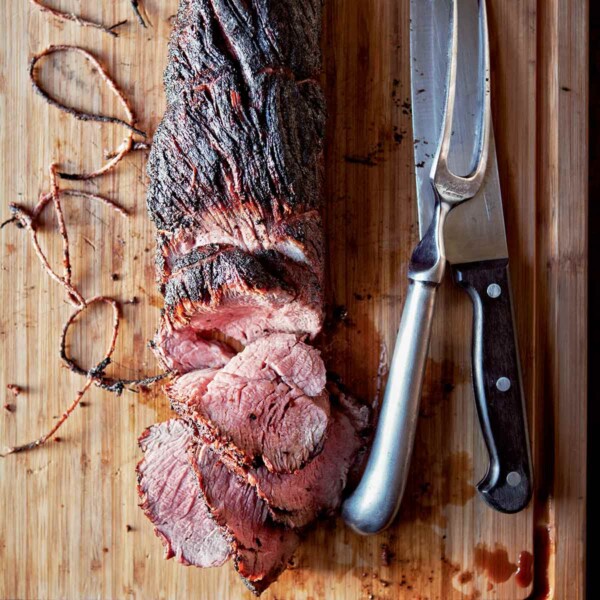
Grilled Beef Tenderloin
Ingredients
For the compound herb butter
- 2 sticks (8 oz) salted butter, room temperature
- 1/2 cup chopped fresh herbs, such as rosemary, sage, and thyme
- 1 small shallot, finely chopped
- 1 garlic clove, finely chopped (optional)
- Kosher salt and freshly ground black pepper
For the grilled beef tenderloin
- 1 (6-to 7-pound) whole beef tenderloin
- 1 tablespoon extra-virgin olive oil, or more, if needed
- 2 tablespoons coarsely ground black pepper, or more, to taste
- Kosher salt
Instructions
Make the compound herb butter
- In a medium bowl, beat the butter with a wooden spoon until creamy and smooth.
- Add the herbs, shallot, and garlic, if using. Season the butter with salt and black pepper and stir until well combined.
Make the grilled beef tenderloin
- Pat the tenderloin dry with paper towels. Using a sharp knife, trim any fat. Slide the blade under the long silvery membrane and remove it.
- Fold about 6 inches (15 cm) of the thin flap end of the meat under the rest of the tenderloin to make it about as thick as the rest of the filet and ensure even cooking. Tie the tenderloin with kitchen string at 3-inch (8-cm) intervals.
- Rub the tenderloin all over with oil. Rub with pepper, pressing it into the meat, and season with salt.
☞ TESTER TIP: Let the tenderloin rest at room temperature for 1 hour before grilling.
- Carefully move the tenderloin to the cooler side of the grill and cook until a thermometer inserted in the thickest part of the meat registers 120°F (49°C) for rare and 130°F (54°C) for medium-rare, 7 to 12 minutes.
- Let the beef rest on a cutting board for at least 20 minutes. Snip off the string, slice the meat, and serve on a platter, or plated and topped with a smear of compound herb butter.
Notes
- Internal temperature–To avoid tough beef, don’t cook past an internal temperature of 145°F. For rare to medium-rare beef, aim for an internal temperature of 125°F.
- Get ahead–The beef can be prepared, seasoned, and tied up to 36 hours before cooking. Store in the refrigerator.
- Storage–Leftovers can be stored in a sealed container in the refrigerator for up to 3 days.
- Dietary–This recipe is suitable for gluten-free and dairy-free diets.

Explore More with AI
Nutrition
Nutrition information is automatically calculated, so should only be used as an approximation.
Recipe Testers’ Reviews
This was the most tender, buttery steak we’ve ever had. Then we topped it with butter. Utterly and perfectly indulgent!
We used a 2-pound tenderloin for our family of 4 (2 adults and 2 kids) so I adjusted the recipe accordingly. I salted the tenderloin 8 hours before cooking and rested the tied meat 1 hour before cooking.
On a medium-hot grill, the tenderloin took about 20 minutes, rotating occasionally, to get crusted. Then I moved it to a cooler side of the grill and cooked an additional 10 minutes. I removed it from the heat when it reached an internal temp of 120°F as we like it rare. I placed my thermometer in the thickest part of the tenderloin, so the end pieces were more medium or medium-rare for the kids.
I let it rest, wrapped in foil, for 15 minutes before slicing. I lost quite a bit of the juice on my cutting board when I sliced it up. I would recommend resting for a few more minutes.
I served this with lemon zest, balsamic, garlic, shallot, green beans, and lemony fettuccini alfredo.
Our family agreed that you can’t even compare grilling individual filets versus grilling the entire tenderloin, they’re two completely different dishes, delicious for different reasons. With individual steaks, you gain more seared surface area, but you don’t miss it here. Grilling the entire filet and then carving made the cut incredibly buttery and tender.
We also agreed that it was easier to feed a crowd with this method, only one piece of meat to manage, and eaters can choose their preferred doneness, rarer toward the center and more done near the ends. We scaled down the meat, so I also scaled down the herb butter, which was amazing.
This dish is a bit of a spend but absolutely worth every penny. And the addition of the compound butter put it over the top. Skip the stuffy steakhouse, grab a nice bottle of red, stay in your PJs, and enjoy this dish with the carnivores you love.
I cater parties and just about every client I have requests a version of this, either as a main course or as an appetizer. This is an excellent basic recipe but I have some recommendations that make it really foolproof.
I always trim my tenderloin beyond what has been done to it in the butcher department. Most butchers will leave the chain attached to the tenderloin. I find that the chain is tough and chewy and causes the meat to cook less evenly, so I always remove it (butchers leave it on not because it tastes great but because it adds to the weight and it’s less work for them to leave it on).
I then tease out the usable meat from the silver skin and save those trimmings in the freezer. When I have enough, I rub them in herbs, garlic, oil, and smoked pimentos and thread them onto skewers and grill them for a tapas-like appetizer.
I like to do a 36-hour rest in the fridge with the rub, uncovered, turning every 12 hours or so, to allow the salted juices to reabsorb into the meat. Sure, seasoning at the last minute works and lets the clean beefy flavor shine through, but if you aren’t able to splurge on prime-grade meat, then a 36-hour rub is a nice alternative. It lets you not have to splurge on the most expensive grade of beef but tastes like a million bucks. It’s also enough time that the meat will reabsorb any salty liquids it has released and yields beautifully flavored meat.
I tie the tenderloin at 1-inch intervals. The more evenly cylindrical the meat is, the more evenly it will cook. Plus, it looks pretty. I always let the tenderloin rest at room temperature for at least one hour (and preferably two) before it goes on the grill or in the oven. The closer to room temp, the more evenly it cooks.
There’s no substitute for a meat thermometer. The heel of your hand isn’t an accurate gauge if you’re looking for perfection. For me, perfection is 122°F in the thickest part of the tenderloin. Stick that thermometer straight into the tenderloin at the thickest end, horizontally through the center length of the roast.
This recipe says to let it rest for 15 minutes, but if you aren’t hell-bent on serving piping hot meat, then let it rest for an hour. It’s so sad to cut into a beef tenderloin only to have it bleed the lovely, salty juices all over the platter because it hasn’t rested long enough.
I didn’t use the compound butter because I was serving it cold and sliced thin, to be placed atop baguette rounds. Instead, I used a sauce of whipped creme fraiche with chives, dijon, and horseradish to accompany.
I seared the meat over medium-high on each of the 4 sides for about 6 minutes on each side until I got a nice color all around. I then turned the grill down to medium-low, closed the cover, and let it cook for another 7 minutes until the thickest part of the meat registered 122°F.
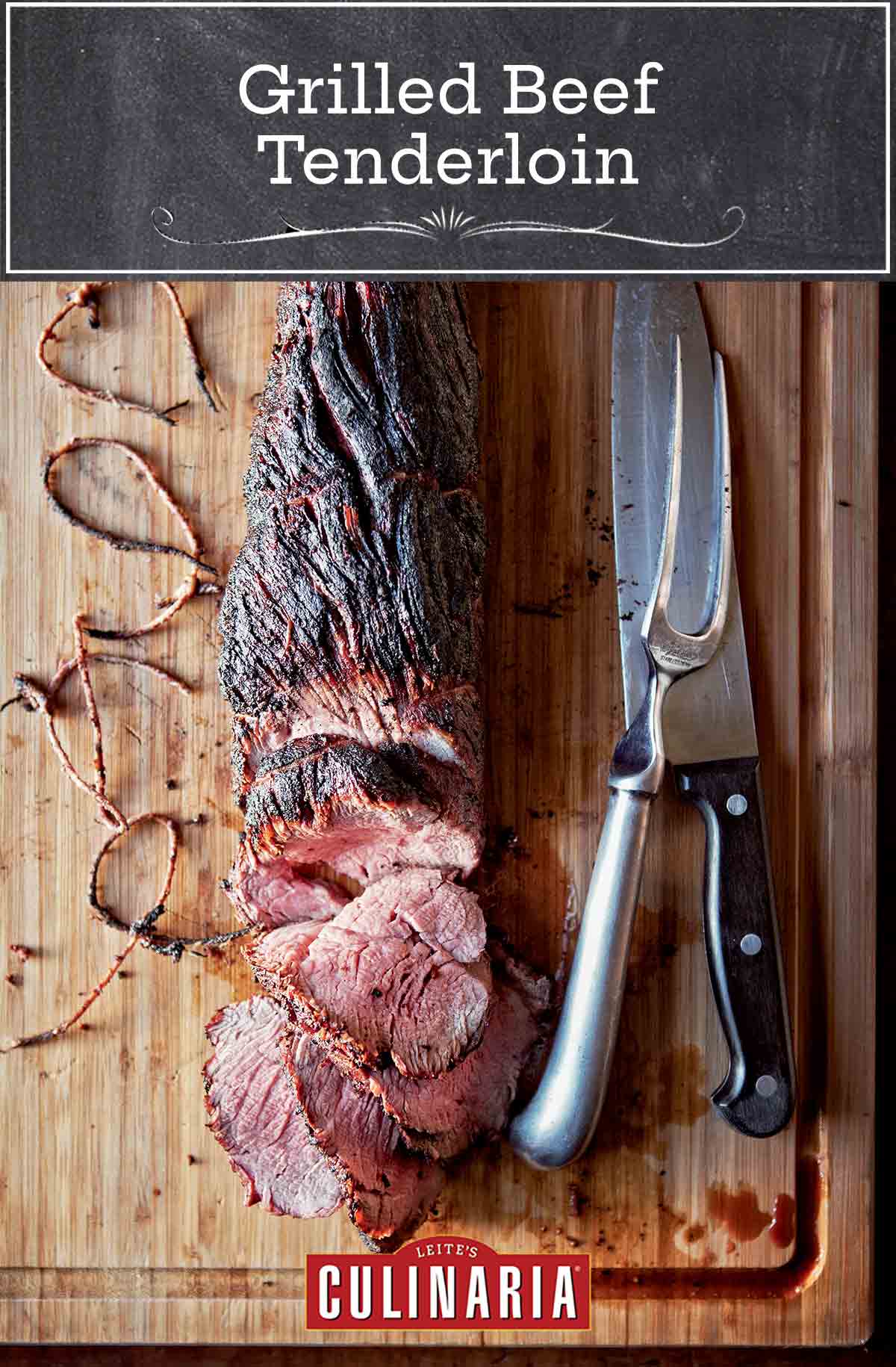
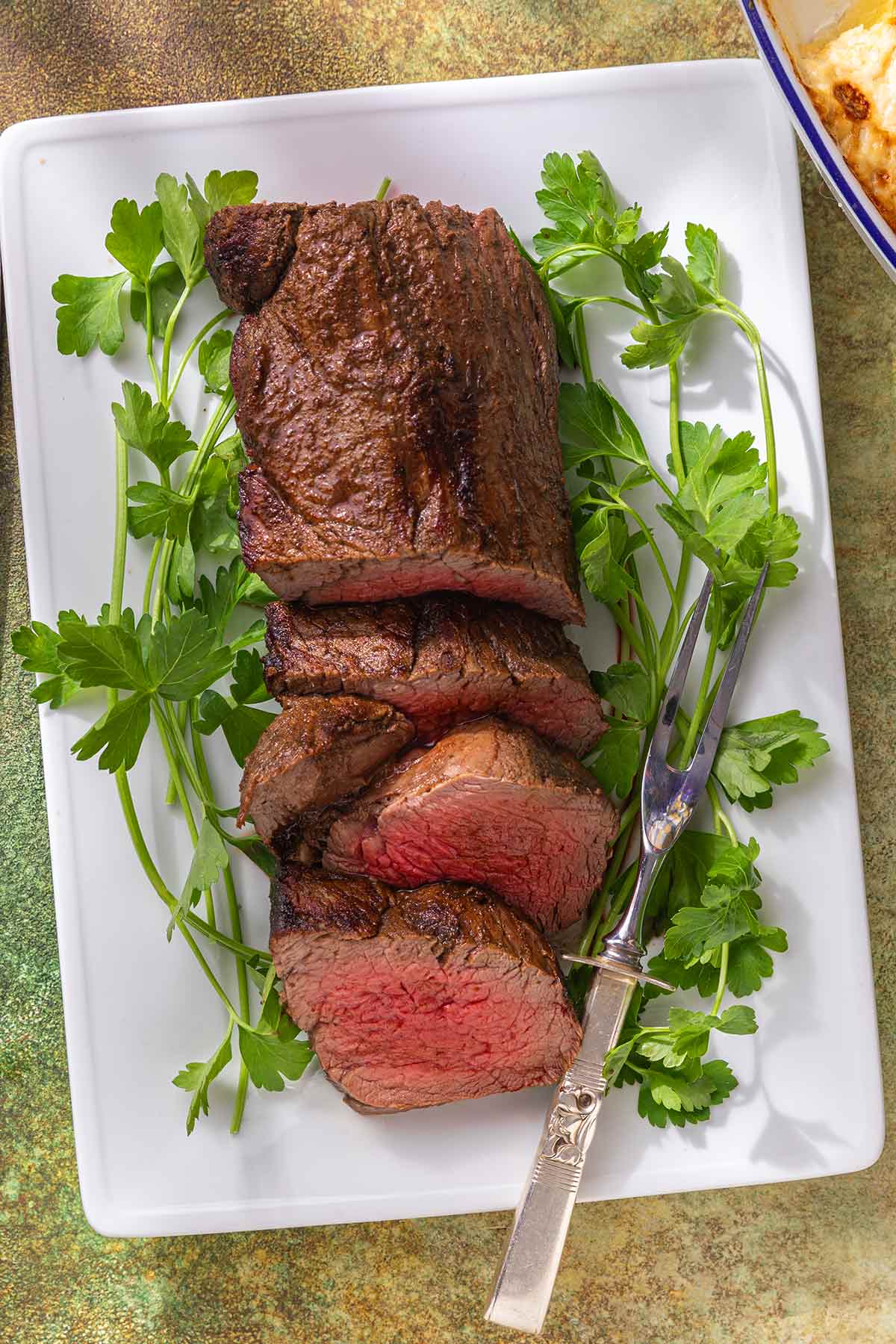
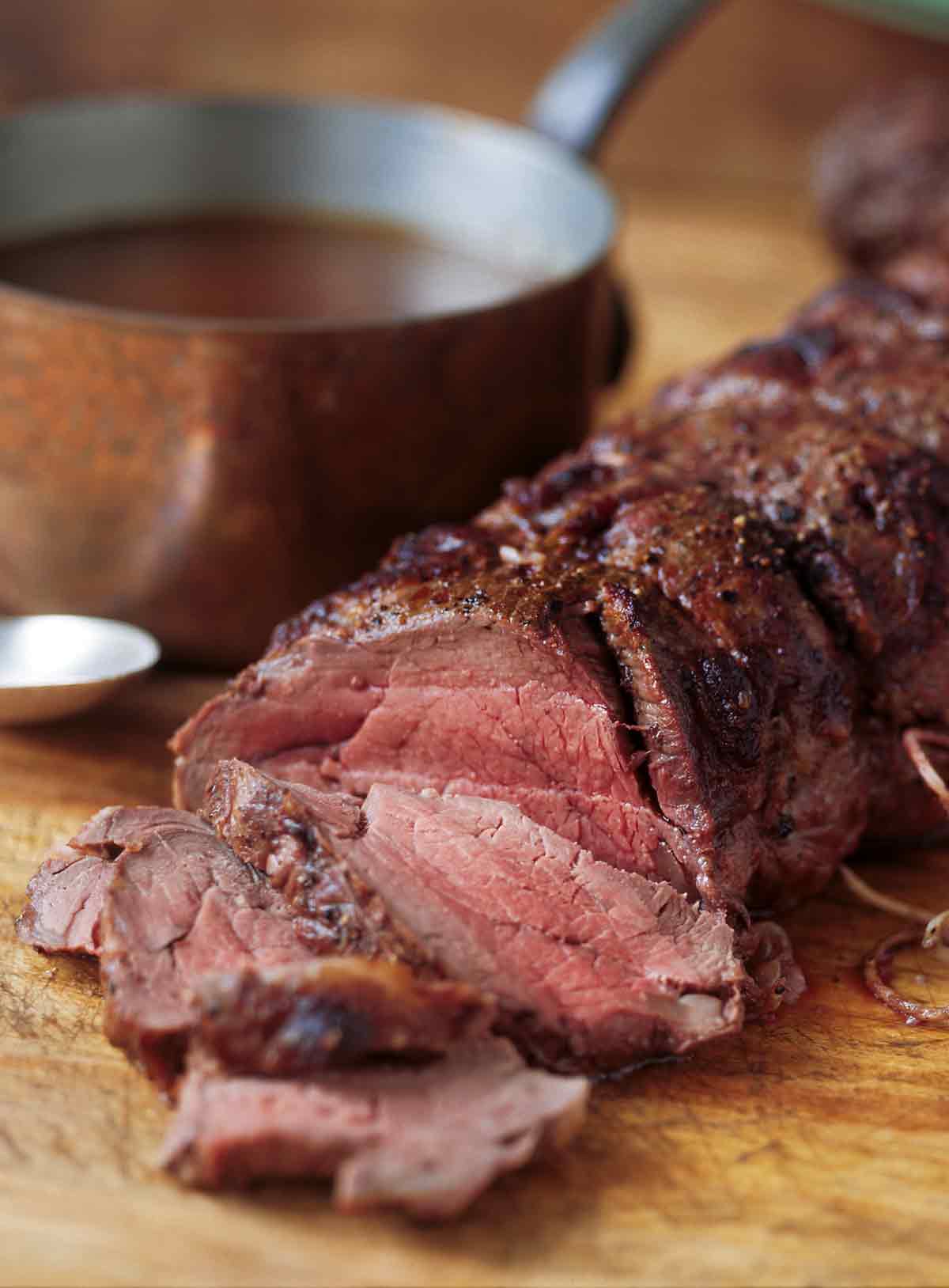












Help! I don’t have a grill. Could I (very) carefully broil it to get a nice sear, then finish by roasting it? Many thanks, as always!
And David, would you please consider adding an auto-capitalize feature? Having to manually capitalize the 1st word, of every sentence, is a pain in the patootie, IMHO. 😬 Thanks.
Terry, I’ve never broiled it. You can definitely try, but with such an expensive piece of meat, I would watch it like a hawk!
We found a 6 lb tenderloin for $61 At the market (we suspect it was meant for restaurants). We grilled it and served it with tarragon blue cheese butter, fries and asparagus
Divine recipe!
How wonderful, Jenny! Sounds like quite the meal.
I cooked this dish following your intructions yesterday. My husband and my son told me it was the best grilled beef they had ever tried. I was so happy. Thank you so much for the recipe.
Rosanna, you’re welcome. This is magnificent to hear! I had the same experience when I made it in terms of it being show-stoppingly lovely. Grateful you found the recipe. And really appreciate you taking the time to let us know how much you love it.